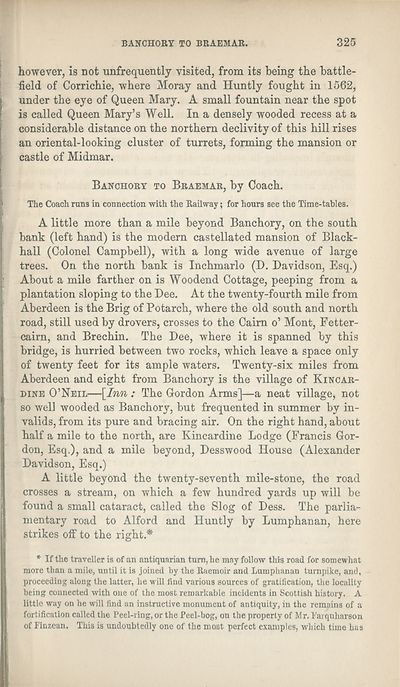Download files
Complete book:
Individual page:
Thumbnail gallery: Grid view | List view

BANCHORY TO BRAEMAR.
325
however, is not unfrequently visited, from its being the battle¬
field of Corrichie, where Moray and Huntly fought in 1562,
under the eye of Queen Mary. A small fountain near the spot
is called Queen Mary’s Well. In a densely wooded recess at a
considerable distance on the northern declivity of this hill rises
an oriental-looking cluster of turrets, forming the mansion or
castle of Midmar.
Banchory to Braemar, by Coach.
The Coach runs in connection with the Railway; for hours see the Time-tables.
A little more than a mile beyond Banchory, on the south
bank (left hand) is the modern castellated mansion of Black¬
ball (Colonel Campbell), with a long wide avenue of large
trees. On the north bank is Inchmarlo (D. Davidson, Esq.)
About a mile farther on is Woodend Cottage, peeping from a
plantation sloping to the Dee. At the twenty-fourth mile from
Aberdeen is the Brig of Potarch, where the old south and north
road, still used by drovers, crosses to the Cairn o’ Mont, Fetter-
cairn, and Brechin. The Dee, where it is spanned by this
bridge, is hurried between two rocks, which leave a space only
of twenty feet for its ample waters. Twenty-six miles from
Aberdeen and eight from Banchory is the village of Kincar¬
dine O’Neil—\Inn : The Gordon Arms]—a neat village, not
so well wooded as Banchory, but frequented in summer by in¬
valids, from its pure and bracing air. On the right hand, about
half a mile to the north, are Kincardine Lodge (Francis Gor¬
don, Esq,), and a mile beyond, Desswood House (Alexander
Davidson, Esq.)
A little beyond the twenty-seventh mile-stone, the road
crosses a stream, on which a few hundred yards up will be
found a small cataract, called the Slog of Dess. The parlia¬
mentary road to Alford and Huntly by Lumphanan, here
strikes off to the right.*
* If the traveller is of an antiquarian turn, he may follow this road for somewhat
more than a mile, until it is joined by the Raemoir and Lumphanan turnpike, and,
proceeding along the latter, he will find various sources of gratification, the locality
being connected with one of the most remarkable incidents in Scottish history. A
little way on he will find an instructive monument of antiquity, in the remains of a
fortification called the Peel-ring, or the Peel-bog, on the property of Mr. I'arquharson
of Finzean. This is undoubtedly one of the most perfect examples, which time has
325
however, is not unfrequently visited, from its being the battle¬
field of Corrichie, where Moray and Huntly fought in 1562,
under the eye of Queen Mary. A small fountain near the spot
is called Queen Mary’s Well. In a densely wooded recess at a
considerable distance on the northern declivity of this hill rises
an oriental-looking cluster of turrets, forming the mansion or
castle of Midmar.
Banchory to Braemar, by Coach.
The Coach runs in connection with the Railway; for hours see the Time-tables.
A little more than a mile beyond Banchory, on the south
bank (left hand) is the modern castellated mansion of Black¬
ball (Colonel Campbell), with a long wide avenue of large
trees. On the north bank is Inchmarlo (D. Davidson, Esq.)
About a mile farther on is Woodend Cottage, peeping from a
plantation sloping to the Dee. At the twenty-fourth mile from
Aberdeen is the Brig of Potarch, where the old south and north
road, still used by drovers, crosses to the Cairn o’ Mont, Fetter-
cairn, and Brechin. The Dee, where it is spanned by this
bridge, is hurried between two rocks, which leave a space only
of twenty feet for its ample waters. Twenty-six miles from
Aberdeen and eight from Banchory is the village of Kincar¬
dine O’Neil—\Inn : The Gordon Arms]—a neat village, not
so well wooded as Banchory, but frequented in summer by in¬
valids, from its pure and bracing air. On the right hand, about
half a mile to the north, are Kincardine Lodge (Francis Gor¬
don, Esq,), and a mile beyond, Desswood House (Alexander
Davidson, Esq.)
A little beyond the twenty-seventh mile-stone, the road
crosses a stream, on which a few hundred yards up will be
found a small cataract, called the Slog of Dess. The parlia¬
mentary road to Alford and Huntly by Lumphanan, here
strikes off to the right.*
* If the traveller is of an antiquarian turn, he may follow this road for somewhat
more than a mile, until it is joined by the Raemoir and Lumphanan turnpike, and,
proceeding along the latter, he will find various sources of gratification, the locality
being connected with one of the most remarkable incidents in Scottish history. A
little way on he will find an instructive monument of antiquity, in the remains of a
fortification called the Peel-ring, or the Peel-bog, on the property of Mr. I'arquharson
of Finzean. This is undoubtedly one of the most perfect examples, which time has
Set display mode to:
![]() Universal Viewer |
Universal Viewer | ![]() Mirador |
Large image | Transcription
Mirador |
Large image | Transcription
| Antiquarian books of Scotland > Scotland/Scots > Black's picturesque tourist of Scotland > (421) |
|---|
| Permanent URL | https://digital.nls.uk/130033242 |
|---|
| Description | Thousands of printed books from the Antiquarian Books of Scotland collection which dates from 1641 to the 1980s. The collection consists of 14,800 books which were published in Scotland or have a Scottish connection, e.g. through the author, printer or owner. Subjects covered include sport, education, diseases, adventure, occupations, Jacobites, politics and religion. Among the 29 languages represented are English, Gaelic, Italian, French, Russian and Swedish. |
|---|

